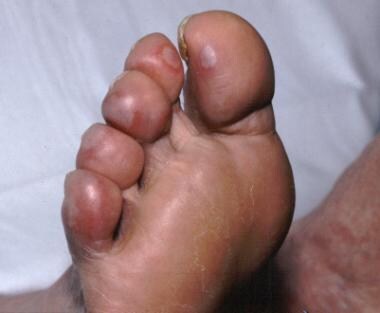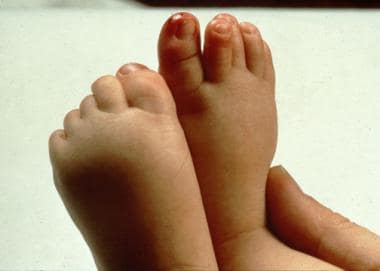Practice Essentials
Pernio is an inflammatory skin condition presenting after exposure to cold as pruritic and/or painful erythematous-to-violaceous acral lesions. Pernio may be idiopathic or secondary to an underlying condition such as immune-mediated inflammatory disorders (IMIDs) with systemic lupus erythematosus (SLE) the most common. [1]
Pernio-like acral lesions in patients with COVID-19 infection (dubbed COVID toes/fingers) is the most common cutaneous manifestation of COVID-19. [2] It usually appears as a later symptom (75%) and is often encountered in children and young adults with milder or asymptomatic COVID-19 infection. [3]
Note the image below.
Pernio lesions can appear on 3% to 12% of the skin, most commonly on the hands, fingers, feet, and toes. There are over twenty clinical symptoms pernio that have been reported; papules, nodules, and itching are the most common. [4]
Pernio can often be diagnosed on the basis of clinical findings. Biopsy may be indicated to rule out other inflammatory processes in difficult chronic cases. Punch biopsy is adequate. The most common histologic findings are perivascular lymphocytic infiltrate (81% of patients), basal epidermal-cell layer vacuolation (67%), papillary dermal edema (66%), and perieccrine lymphocytic infiltrate (57%). [4]
Treatment of idiopathic pernio includes avoidance of exposure to cold, smoking cessation, calcium-channel blockers, and topical steroids. [5] Secondary pernio due to SLE (Chilblain lupus erythematosus [CHLE]) is treated with corticosteroids, immunosuppressive agents, and calcium-channel blockers. Refractory cases of CHLE have been successfully treated with anifrolumab, a monoclonal antibody. [6]
To prevent recurrence, patients should be advised to avoid exposure to cold, keep extremities warm and dry and cease smoking. For patient education resources see, Cold Hands and Feet.
Pathophysiology
Pernio is due to an abnormal vascular response to cold exposure, [7] and it is most frequent when damp or humid conditions coincide. Minor trauma also may predispose the acral parts to symptomatic pernio lesions in otherwise appropriate weather conditions. Hyperhidrosis and low lody mass index are suggested associations. [8] The response of pernio to vasodilator drugs varies. Keeping acral areas warm and dry best prevents pernio.
Etiology
The direct cause of pernio is cold exposure; specifically, exposure to both mild nonfreezing cold and humidity seems to be required. [9, 10] Chronic pernio may be secondary to various systemic diseases as follows:
-
Dysproteinemias
-
Macroglobulinemia
-
Cryoglobulinemia, cryofibrinogenemia, cold agglutinins
Variants include the following:
-
Kibes (equestrian cold panniculitis): Erythrocyanotic plaques occur on the upper lateral thighs of women who ride horses. Histology is characterized by an intense perivascular infiltrate extending into subcutaneous fat.
-
Chilblain lupus erythematosus (CHLE) [16, 17] : Violaceous "pernio" plaques appear prominent over dorsal interphalangeal joints, often with positive antinuclear antibody (ANA) or rheumatoid factor (RF). Histologic and immunofluorescent evidence of lupus is present in the skin lesions. Half of the patients have associated facial discoid lupus lesions, and 15% develop systemic lupus.
-
Drug-induced pernio: Sulindac-induced cases have been reported. [18]
-
Posttraumatic unilateral perniosis [19]
Epidemiology
Frequency
United States
The true incidence of pernio is unknown because pernio frequently is unrecognized or misdiagnosed.
International
Rates of pernio vary with climate. England, with its cool damp climate, has an annual incidence rate of pernio of 10%. A clustering of pernio cases has been reported from Hong Kong during January and February, with resolution of most cases within a few weeks when the weather warmed. [20]
Sex
Women are affected by pernio more frequently than men.
Age
Pernio is most frequent in young and middle-aged women and in children. Note the image below.
Prognosis
Prognosis is good. Recurrences may be observed annually with onset of cold weather. [13] Long-term follow-up of patients with chronic recurrent pernio is advised because this may reveal connective-tissue disease (lupus erythematosus). Most cases of pernio resolve without any adverse reactions. Pernio lesions that blister may become secondarily infected.
-
Erythematous macules on distal toes of a 6-month-old girl with pernio.
-
Close-up of erythematous macules and plaques on distal plantar toes.
-
A 63-year-old man with pernio presenting as acral violaceous plaques with bullae.
-
Close-up of great toe bulla.



